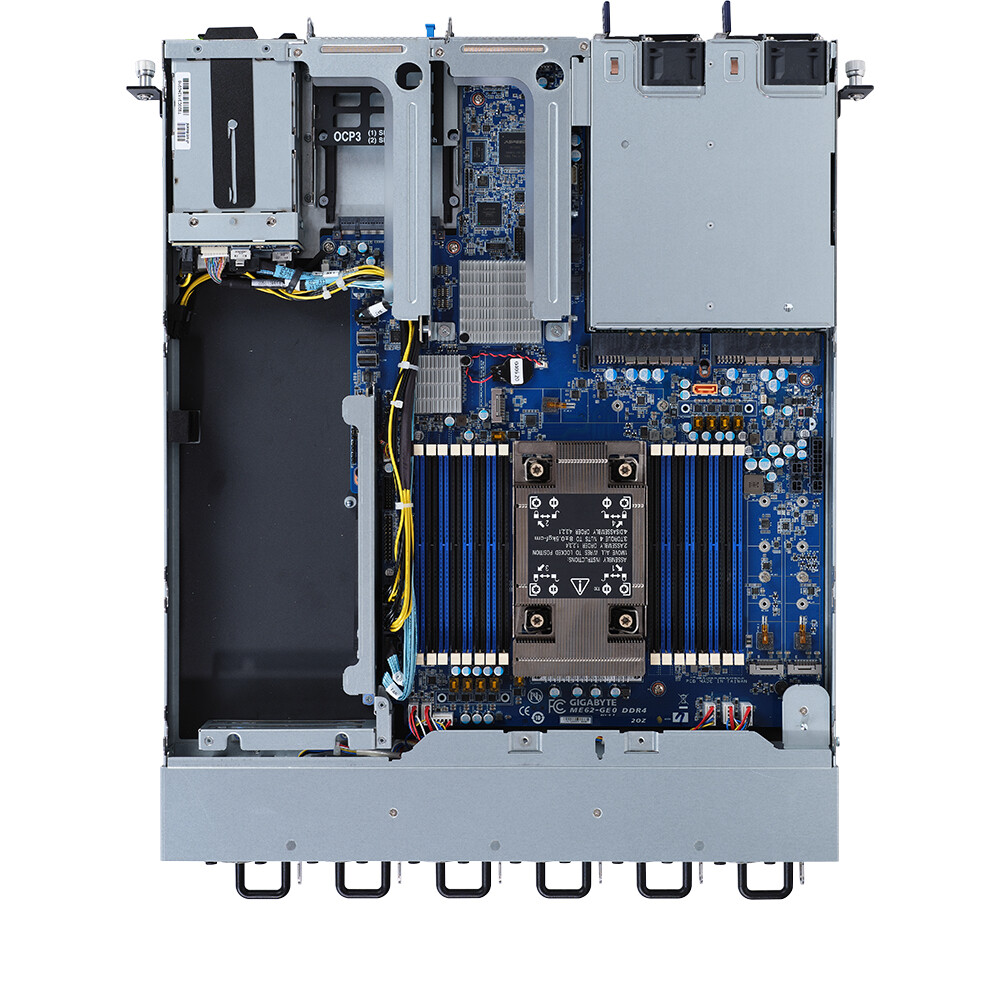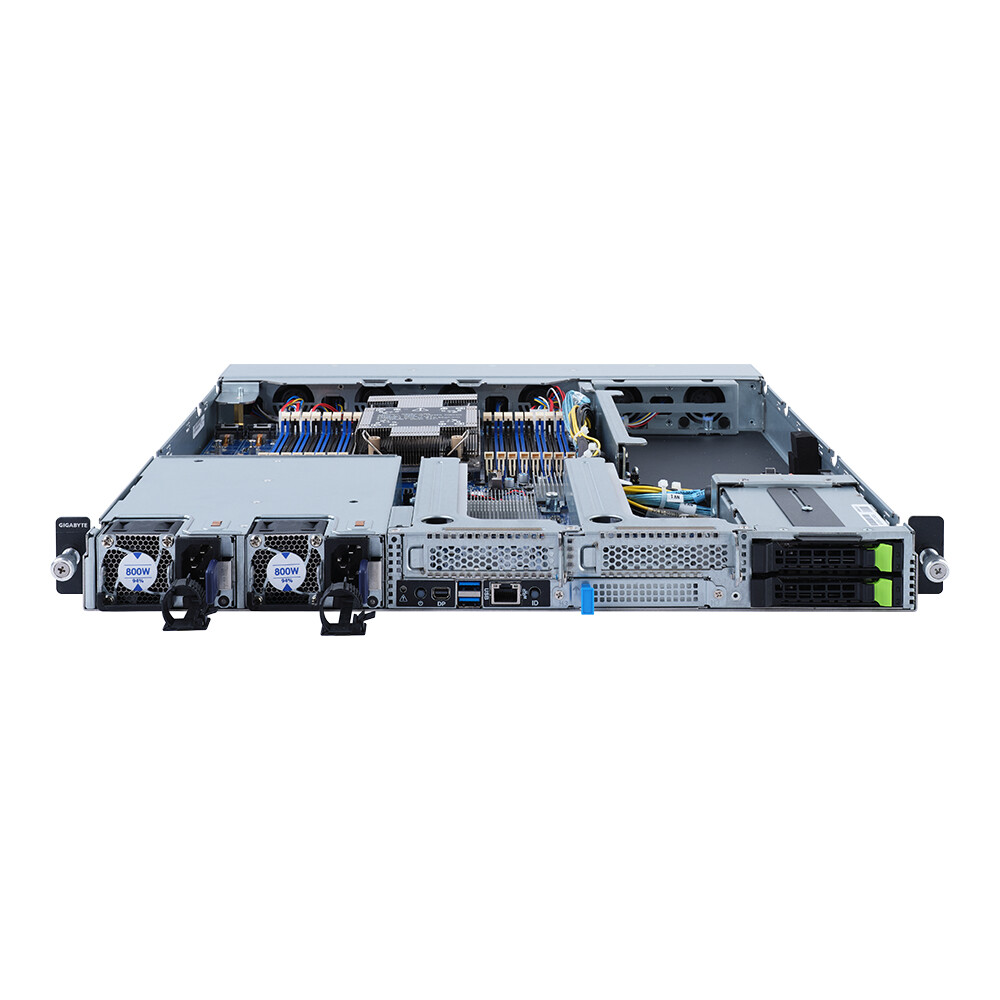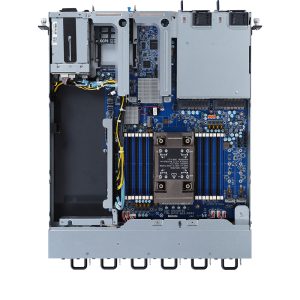Gigabyte E162-220 Intel C621A LGA 4189 Stativ (1U) Sort
22.456,25 kr. inkl. moms (ex. moms 17.965,00 kr.)
Rack (1U) Black
Ikke på lager
Giv mig besked når varen kan købes

Where Compute Reigns
3rd Gen Intel Xeon Scalable Processors – “Ice Lake”
GIGABYTE servers and Intel Xeon Scalable Processors deliver incredible 1P/2P performance from edge to data center with incredible gains in I/O throughput and workload demands that need high performing CPUs with large, yet optimized, memory configurations.
Enhanced I/0: Support for PCIe 4.0 allows for double the throughput of PCIe 3.0 for fast and large data transfers. Also, 64 lanes per socket with up to 128 lanes in a 2P configuration for fast data transmission from CPU to GPU, accelerator or storage.
CPU Performance Boost: Now up to 40 cores per socket with greatly improved IPC on Intel’s 10nm architecture while operating CPUs at 105-270W. Also, an additional UPI lane is added for up to 11.2GT/s for a low latency interconnect between CPUs.
Next Gen Memory: Each processor provides eight memory channels to support 8 or 16 DIMM slots with up to DDR4-3200. There are two sub-clustering modes, Sub NUMA (SNC) and Hemisphere (HEMI), available using balanced memory that results in performance improvements. Additionally, support for Intel Optane PMem 200 series provides two modes for greater memory capacity and data persistence to process large amounts of data faster.
Next Level Security: New instructions and architecture deliver a high level of cryptographic operations for data privacy and protection. Cryptographic accelerators speed up encryption protocols as well as improvements in software guard extensions and memory encryption are added.
AI Acceleration: AI inference and training are enhanced with DL Boost Technology for greater business, operational, and security insights. Applications include HPC, AI, and Media & Graphics.
Edge Computing
Front access I/O make it easy to maintain
For quick access to storage, GPU, add-in cards, NICs, LAN ports, and power supplies, GIGABYTE edge servers bring all of them to the front. As well, tool-less design for drive bays and hot swappable FAN make it easy to maintain.
Accelerator Computing
Short chassis with high performance
Offering support for dual slot GPUs allows for the highest, dense GPU compute possible in a short chassis. Delivering the fastest throughput for data, PCIe Gen 4 lanes are all in x16 mode for a total bandwidth of 64GB/s per GPU.
Flexibility
Various storage for 2.5” and M.2 SSD
GIGABYTE servers have incorporated a high level of flexibility. M.2 slots permit flexible storage in a short chassis. As well, various expansion slots can house dual slot GPU cards or other accelerators, with additional options for NICs and OCP solutions.
High Performance
OCP 3.0 Ready
GIGABYTE offers servers that feature an onboard OCP 3.0 slot for the next generation of add on cards. Advantages of this new type include:
Easy Serviceability: simply slot in or pull out the card, without opening the server or using tools
Improved thermal design: horizontal position and optimal heat sink design allow for air cooling to eliminate the heat efficiently
Support Various Computing Accelerators
GIGABYTE servers have been tested and validated across a range of workloads with various computing accelerators designed to deliver high levels of performance for 3D rendering, deep learning and high-performance computing, which enables content creators, data scientists, researchers, and engineers to tackle challenges that were once impossible.
Power Efficiency
Automatic Fan Speed Control
GIGABYTE servers are enabled with Automatic Fan Speed Control to achieve the best cooling and power efficiency. Individual fan speeds will be automatically adjusted according to temperature sensors strategically placed in the servers.
High Availability
Smart Crises Management and Protection (SCMP)
SCMP is a GIGABYTE patented feature which is deployed in servers with non-fully redundant PSU design. With SCMP, in the event of faulty PSU or overheated system, the system will force the CPU into an ultra-low power mode that reduces the power load, which prevents the system from unexpected shutdown and avoids component damage or data loss.
Dual ROM Architecture
If the ROM that stores the BMC and BIOS fails to boot, the system will reboot with the backup BMC and/or BIOS replacing the primary. Once the primary BMC is updated, the ROM of the backup BMC will automatically update the backup through synchronization. For the BIOS, it can be updated based on user’s choice of firmware version.
Hardware Security
Optional TPM 2.0 Module
For hardware-based authentication, the passwords, encryption keys, and digital certificates are stored in a TPM module to prevent unwanted users from gaining access to your data. GIGABYTE TPM modules come in either a Serial Peripheral Interface or Low Pin Count bus.
User Friendly
Certified Ready with Software Partners
Being a member of key software alliance partner programs enables GIGABYTE to together rapidly develop and validate joint solutions, enabling our customers to modernize their data centers and implement IT infrastructure and application services with speed, agility, and cost optimization. GIGABYTE servers have a compatibility across various ecosystems.
Value-added Management
GIGABYTE offers free-of-charge management applications via a specialized small processor built on the server.
GIGABYTE Management Console
For management and maintenance of a server or a small cluster, users can use the GIGABYTE Management Console, which is pre-installed on each server. Once the servers are running, IT staff can perform real-time health monitoring and management on each server through the browser-based graphical user interface. In addition, the GIGABYTE Management Console also provides:
Support for standard IPMI specifications that allows users to integrate services into a single platform through an open interface
Automatic event recording, which can record system behavior 30 seconds before an event occurs, making it easier to determine subsequent actions
Integrate SAS/SATA/NVMe devices and RAID controller firmware into GIGABYTE Management Console to monitor and control Broadcom MegaRAID adapters.
GIGABYTE Server Management (GSM)
GSM is a software suite that can manage clusters of servers simultaneously over the internet. GSM can be run on all GIGABYTE servers and has support for Windows and Linux. GSM can be downloaded from GIGABYTE website and complies with IPMI and Redfish standards. GSM includes a complete range of system management functions that includes the following utilities:
GSM Server: A software program that provides real-time, remote control using a graphical user interface through an administrator’s computer or through a server in the cluster. The software allows ease of maintenance for large clusters of servers.
GSM CLI: A command-line interface for monitoring and managing remotely.
GSM Agent: A software program installed on each GIGABYTE server node that retrieves information from each system and devices through the OS, and this software integrates with GSM Server or GSM CLI.
GSM Mobile: A mobile app for both Android and iOS that provides admins with real-time system information.
GSM Plugin: An application program interface that allows users to use VMware vCenter for real-time monitoring and management of server clusters.
| Vægt | 0,0000 kg |
|---|---|
| Indbygget processer | Ingen |
| Brand | Gigabyte |
| State | Default |
| Bundkort chipsæt | Intel C621A |
| Antal understøttede processorer | 1 |
| Antal DIMM-slots | 16 |
| Understøttede hukommelsestyper | DDR4-SDRAM |
| Antal understøttede lagerdiske | 2 |
| Hot-swap HDD båse | Ja |
| Antal 2.5" bays | 2 |
| Understøttede lagerdisk størrelser | 2.5" |
| Ethernet LAN | Ja |
| Ethernet-grænsefladetype | Gigabit Ethernet |
| Ethernet LAN-porte (RJ-45) | 1 |
| Antal USB 3.2 Gen 1 (3.1 Gen 1) type-A-porte | 2 |
| Kabinettype | Stativ (1U) |
| Produktfarve | Sort |
| LED-indikatorer | Ja |
| Bredde | 438 mm |
| Dybde | 500 mm |
| Højde | 43,5 mm |
| Processor sokkel | LGA 4189 |
| Understøttet RDIMM-clockhastigheder | 2666,2933,3200 MHz |
| RAID-niveauer | 0, 1 |
| Ethernet LAN-datahastigheder | 10,100,1000 Mbit/s |
| PCI Express slots version | 4.0 |
| PCI Express x16 slots | 3 |
| Understøttelse af backplane | Ja |
| Harmoniseret systemkode (HS) | 84714100 |
| Strømforsyning | 800 W |
| On-board grafikkort, model | Aspeed AST2600 |
| Knap til nulstilling | Ja |
| Antal blæsere | 6 blæser(e) |
| Ventilator diameter | 4 cm |
| Antal installerede strømforsyninger | 2 |
| 80 PLUS certificering | 80 PLUS Platinum |
| Driftstemperatur (T-T) | 10 – 35 °C |
| Opbevaringstemperatur (T-T) | -40 – 60 °C |
| Relativ luftfugtighed ved drift (H-H) | 8 – 80% |
| Relativ luftfugtighed ved opbevaring (H-H) | 20 – 95% |
| Tænd-/slukkontakt | Ja |
| Pakkebredde | 786 mm |
| Pakkedybde | 588 mm |
| Pakkehøjde | 250 mm |
| Hukommelseskanaler | Okta-kanal |
| Antal M.2 (M) slots | 3 |
| Antal mini DisplayPorts | 1 |


















